The global E glass fiber milled fiber market is valued at USD 174.3 million in 2025 and is set to reach USD 265.6 million by 2035, recording an absolute increase of USD 91.3 million over the forecast period. Demand for E glass fiber milled fiber translates into a total growth of 52.4%, with the market forecast to expand at a compound annual growth rate (CAGR) of 4.3% between 2025 and 2035. The increasing emphasis on material efficiency, performance reliability, and process compatibility across composite manufacturing environments shapes key trends in the E-glass fiber milled fiber market. One major trend is the growing integration of milled fiber into high-flow thermoplastic and thermoset molding compounds, where uniform fiber length distribution enhances mechanical strength without compromising moldability. This is especially important for automotive lightweighting initiatives, where components require improved stiffness-to-weight ratios while supporting faster cycle times in injection molding operations.
Another key trend is the expansion of milled fiber usage in 3D printing and additive manufacturing feedstocks, where fine reinforcement distribution supports improved dimensional stability and part durability. In aerospace and wind energy sectors, demand is shifting toward high-performance resin reinforcement systems that can withstand fatigue, stress, and environmental exposure, increasing the need for consistent fiber sizing and controlled fiber-matrix bonding behavior. Additionally, surface-treated and specialty-coated milled fibers are gaining adoption to improve wet-out characteristics and interfacial adhesion in advanced composites. There is also a rising focus on process optimization and dispersion control, ensuring predictable mechanical properties and reducing variability in high-volume composite production.

The market encompasses various fiber lengths, surface treatments, and specialized formulations tailored for specific composite applications. Modern E glass fiber milled products incorporate advanced sizing chemistries, controlled aspect ratios, and optimized surface modifications that can deliver enhanced adhesion characteristics while maintaining processing efficiency across diverse manufacturing conditions. The integration of specialized coating systems, improved dispersion technologies, and enhanced compatibility features has further enhanced the value proposition of these fiber systems among manufacturers seeking performance optimization and processing consistency.
Market dynamics are significantly influenced by stringent weight reduction requirements, particularly in automotive applications, aerospace components, and transportation systems where material performance optimization and structural efficiency are paramount. The manufacturing sector's increasing emphasis on composite materials, advanced processing technologies, and performance enhancement has created substantial demand for high-quality milled fiber solutions in thermoplastic compounding, sheet molding compound production, and specialized reinforcement applications. Additionally, the growing trend toward advanced manufacturing processes and automated production systems has amplified the need for consistent fiber products capable of integration with modern composite manufacturing networks and quality control platforms.
Consumer purchasing patterns show a marked preference for engineered fiber systems that combine mechanical performance capabilities with versatile processing options, multiple surface treatment configurations, and comprehensive technical support services for diverse composite manufacturing applications. The market has witnessed significant technological advancement in fiber cutting technology, surface treatment development, and quality control systems, making these materials more suitable for demanding processing environments, extended production cycles, and performance-critical applications.
Between 2025 and 2030, the E glass fiber milled fiber market is projected to expand from USD 174.3 million to USD 214.2 million, resulting in a value increase of USD 39.9 million, which represents 43.7% of the total forecast growth for the decade. This phase of development will be shaped by increasing composite material adoption, rising demand for lightweight reinforcement solutions, and growing availability of advanced milled fiber processing systems across automotive manufacturing and aerospace applications.
Between 2030 and 2035, the market is forecast to grow from USD 214.2 million to USD 265.6 million, adding another USD 51.4 million, which constitutes 56.3% of the overall ten-year expansion. This period is expected to be characterized by the advancement of automated composite manufacturing systems, the development of performance-optimized fiber formulations for specialized applications, and the expansion of advanced reinforcement networks across diverse industrial and transportation applications. The growing emphasis on material performance optimization and processing efficiency will drive demand for premium milled fiber varieties with enhanced mechanical characteristics, improved processing compatibility, and superior quality consistency profiles.
Between 2020 and 2024, the E glass fiber milled fiber market experienced steady growth, driven by increasing composite material requirements and growing recognition of milled fiber technology's superior performance in reinforcement applications following extensive industry validation campaigns. The market developed as manufacturers recognized the advantages of milled glass fibers over conventional reinforcement alternatives in performance-sensitive applications and began seeking specialized solutions designed for precise composite manufacturing requirements. Technological advancement in fiber processing technology and surface treatment chemistry began emphasizing the critical importance of maintaining mechanical performance while enhancing processing characteristics and improving material compatibility across diverse composite manufacturing applications.
| Metric | Value |
|---|---|
| Estimated Value in (2025E) | USD 174.3 million |
| Forecast Value in (2035F) | USD 265.6 million |
| Forecast CAGR (2025 to 2035) | 4.3% |
From 2030 to 2035, the market is forecast to grow from USD 214.2 million to USD 265.6 million, adding another USD 51.4 million, which constitutes 56.3% of the overall ten-year expansion. This period is expected to be characterized by the advancement of intelligent manufacturing integration in composite production systems, the integration of advanced quality control systems for optimal material performance, and the development of specialized fiber configurations for high-performance manufacturing applications. The growing emphasis on material optimization and processing reliability will drive demand for premium varieties with enhanced mechanical performance capabilities, improved surface treatment options, and superior automated processing characteristics.
Between 2020 and 2024, the E glass fiber milled fiber market experienced robust growth, driven by increasing awareness of composite material advantages and growing recognition of specialized fiber systems' effectiveness in supporting efficient manufacturing operations across automotive facilities and aerospace production applications. The market developed as users recognized the potential for E glass fiber milled products to deliver performance advantages while meeting modern requirements for precise reinforcement control and reliable mechanical performance. Technological advancement in fiber processing optimization and surface treatment development began emphasizing the critical importance of maintaining processing efficiency while extending material performance and improving manufacturer satisfaction across diverse milled fiber applications.
Market expansion is being supported by the increasing global emphasis on lightweight materials and the corresponding shift toward high-performance composite systems that can provide superior mechanical reinforcement characteristics while meeting user requirements for precision manufacturing operation and cost-effective processing solutions. Modern composite manufacturers are increasingly focused on incorporating fiber systems that can enhance structural performance while satisfying demands for consistent, precisely controlled material distribution and optimized processing characteristics. E glass fiber milled products' proven ability to deliver reinforcement excellence, processing efficiency benefits, and diverse application possibilities makes them essential components for performance-focused facilities and quality-focused composite professionals.
The growing emphasis on advanced manufacturing standards and material performance optimization is driving demand for high-performance milled fiber systems that can support distinctive processing outcomes and comprehensive reinforcement management across automotive applications, aerospace installations, and premium composite systems. User preference for fiber solutions that combine functional excellence with processing consistency is creating opportunities for innovative implementations in both traditional and emerging composite manufacturing applications. The rising influence of automated manufacturing technologies and advanced quality systems is also contributing to increased adoption of engineered milled fiber solutions that can provide authentic performance benefits and reliable processing characteristics.
The market is segmented by type, application, fiber length, surface treatment, and region. By type, the market is divided into alkali-free glass fiber type, medium alkali glass fiber type, and other specialty formulations. Based on application, the market is categorized into BMC molding, thermoplastic compounding, sheet molding compounds, and others. By fiber length, the market includes short length, medium length, and long length categories. By surface treatment, the market encompasses silane treated, amino silane treated, and specialty coating configurations. Regionally, the market is divided into North America, Europe, Asia Pacific, Latin America, Middle East & Africa, and other regions.

The alkali-free glass fiber type segment is projected to account for 62.4% of the E glass fiber milled fiber market in 2025, reaffirming its position as the leading type category. Composite manufacturers and processing professionals increasingly utilize alkali-free systems for their superior chemical resistance characteristics, established performance standards, and essential functionality in diverse high-performance composite applications across multiple manufacturing sectors. Alkali-free fibers' proven mechanical characteristics and established processing compatibility directly address user requirements for reliable reinforcement control and optimal structural precision in automotive and aerospace applications.
This type segment forms the foundation of modern high-performance composite manufacturing patterns, as it represents the fiber configuration with the greatest application versatility and established compatibility across multiple composite processing systems. Manufacturing investments in advanced composite technology and performance optimization continue to strengthen adoption among quality-focused users. With composite manufacturers prioritizing mechanical performance and processing reliability, alkali-free systems align with both performance objectives and processing requirements, making them the central component of comprehensive reinforcement strategies.
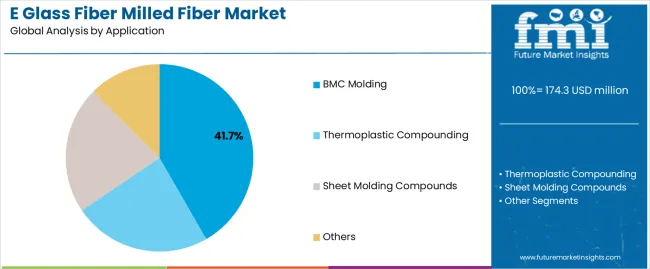
BMC molding is projected to represent 41.7% of the E glass fiber milled fiber market in 2025, underscoring its critical role as the primary application for performance-focused users seeking superior composite manufacturing benefits and enhanced material processing credentials. BMC manufacturers and molding operators prefer BMC applications for their established processing requirements, proven material demand, and ability to maintain exceptional structural precision while supporting versatile manufacturing coverage during diverse molding activities. Positioned as essential applications for performance-focused composite manufacturers, BMC offerings provide both processing excellence and material optimization advantages.
The segment is supported by continuous improvement in molding automation technology and the widespread availability of established BMC standards that enable performance assurance and premium positioning at the manufacturing level. Additionally, BMC users are optimizing fiber selections to support application-specific processing and comprehensive manufacturing automation strategies. As composite molding technology continues to advance and facilities seek efficient processing methods, BMC applications will continue to drive market growth while supporting manufacturing efficiency and material optimization strategies.
The E glass fiber milled fiber market is advancing rapidly due to increasing composite material adoption and growing need for high-performance reinforcement solutions that emphasize superior mechanical performance across automotive segments and aerospace manufacturing applications. However, the market faces challenges, including competition from alternative reinforcement technologies, processing complexity considerations, and material cost factors affecting adoption rates. Innovation in mechanical performance enhancement and advanced surface treatment systems continues to influence market development and expansion patterns.
The growing adoption of E glass fiber milled products with automated processing connectivity and smart manufacturing integration is enabling users to develop composite strategies that provide distinctive quality benefits while commanding automated operation and enhanced real-time performance analysis characteristics. Smart manufacturing applications provide superior processing consistency while allowing more sophisticated quality optimization features across various composite categories. Users are increasingly recognizing the performance advantages of intelligent fiber positioning for comprehensive manufacturing control outcomes and technology-integrated facility management.
Modern E glass fiber milled manufacturers are incorporating advanced surface chemistry systems, real-time quality monitoring capabilities, and performance analytics systems to enhance processing precision, improve mechanical effectiveness, and meet manufacturing demands for intelligent reinforcement solutions. These systems improve processing effectiveness while enabling new applications, including continuous quality monitoring programs and automated optimization protocols. Advanced treatment integration also allows users to support proactive performance positioning and quality assurance beyond traditional fiber processing requirements.
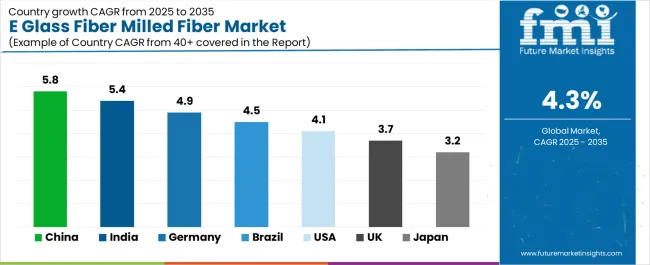
| Country | CAGR (2025-2035) |
|---|---|
| China | 5.8% |
| India | 5.4% |
| Germany | 4.9% |
| Brazil | 4.5% |
| USA | 4.1% |
| UK | 3.7% |
| Japan | 3.2% |
The E glass fiber milled fiber market is experiencing robust growth globally, with China leading at a 5.8% CAGR through 2035, driven by the expanding automotive manufacturing sector, growing composite material requirements, and increasing adoption of advanced reinforcement systems. India follows at 5.4%, supported by rising industrial development, expanding aerospace manufacturing industry, and growing acceptance of composite technologies. Germany shows growth at 4.9%, emphasizing established automotive engineering standards and comprehensive composite manufacturing development. Brazil records 4.5%, focusing on industrial modernization and composite material growth. The USA demonstrates 4.1% growth, prioritizing advanced manufacturing technologies and material optimization.
The report covers an in-depth analysis of 40+ countries, the top-performing countries are highlighted below.
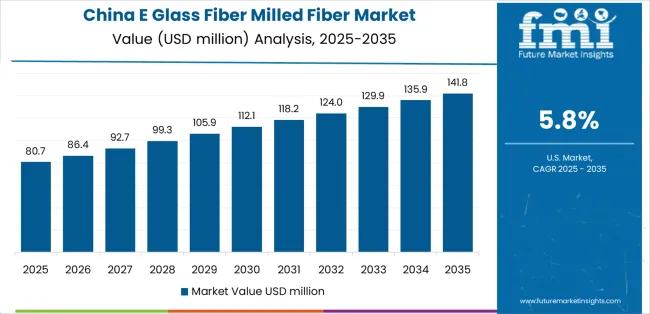
Revenue from E glass fiber milled fiber consumption and sales in China is projected to exhibit exceptional growth with a CAGR of 5.8% through 2035, driven by the country's rapidly expanding automotive manufacturing sector, favorable government policies toward composite material modernization, and initiatives promoting advanced manufacturing technologies across major industrial regions. China's position as a global manufacturing hub and increasing focus on lightweight material systems are creating substantial demand for high-quality E glass fiber milled products in both domestic and export markets. Major composite material companies and automotive suppliers are establishing comprehensive fiber capabilities to serve growing demand and emerging manufacturing opportunities.
Revenue from E glass fiber milled fiber products in India is expanding at a CAGR of 5.4%, supported by rising industrial investment, growing composite consciousness, and expanding material distributor capabilities. The country's developing manufacturing infrastructure and increasing investment in composite technologies are driving demand for milled fiber products across both traditional and modern industrial applications. International composite material companies and domestic distributors are establishing comprehensive operational networks to address growing market demand for reinforcement materials and efficient manufacturing solutions.
Revenue from E glass fiber milled fiber products in Germany is projected to grow at a CAGR of 4.9% through 2035, supported by the country's mature engineering standards, established automotive manufacturing regulations, and leadership in composite technology. Germany's sophisticated manufacturing standards and strong support for advanced material systems are creating steady demand for both traditional and innovative milled fiber varieties. Leading composite material manufacturers and specialty distributors are establishing comprehensive operational strategies to serve both domestic markets and growing export opportunities.
Revenue from E glass fiber milled fiber products in Brazil is projected to grow at a CAGR of 4.5% through 2035, driven by the country's emphasis on industrial development, manufacturing modernization growth, and growing composite distributor capabilities. Brazilian manufacturing users and industrial facilities consistently seek performance-focused materials that enhance operational performance and support modernization excellence for both traditional and modern composite applications. The country's position as a Latin American manufacturing leader continues to drive innovation in specialized reinforcement applications and composite manufacturing standards.
Revenue from E glass fiber milled fiber products in the USA is projected to grow at a CAGR of 4.1% through 2035, supported by the country's emphasis on manufacturing technology advancement, material performance optimization, and advanced composite system integration requiring efficient reinforcement solutions. American manufacturing users and composite-focused facilities prioritize performance reliability and material precision, making specialized E glass fiber milled products essential components for both traditional and modern composite manufacturing applications. The country's comprehensive manufacturing technology leadership and advancing material patterns support continued market expansion.
Revenue from E glass fiber milled fiber products in the UK is projected to grow at a CAGR of 3.7% through 2035, supported by established manufacturing standards, mature composite markets, and emphasis on material efficiency across automotive and aerospace sectors. British manufacturing users and composite professionals prioritize quality performance and operational consistency, creating steady demand for premium fiber solutions. The country's comprehensive market maturity and established manufacturing practices support continued development in specialized applications.
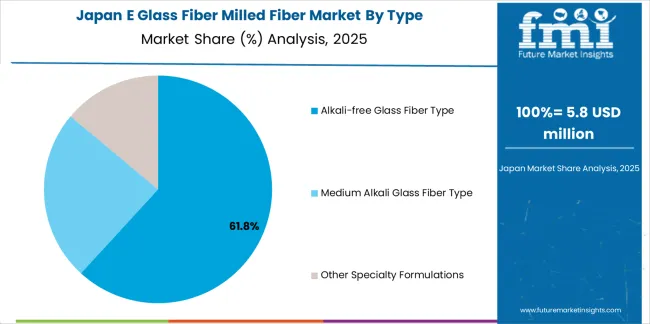
Revenue from E glass fiber milled fiber products in Japan is projected to grow at a CAGR of 3.2% through 2035, supported by the country's emphasis on precision engineering, operational excellence, and advanced technology integration requiring efficient reinforcement solutions. Japanese manufacturing users and composite-focused facilities prioritize technical performance and engineering precision, making specialized E glass fiber milled products essential components for both traditional and modern composite manufacturing applications. The country's comprehensive engineering leadership and advancing precision patterns support continued market expansion.
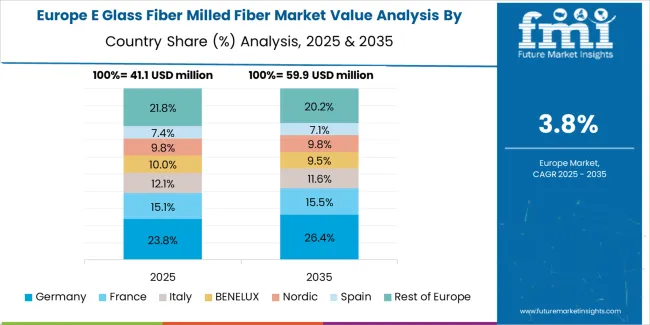
The Europe E glass fiber milled fiber market is projected to grow from USD 52.1 million in 2025 to USD 79.3 million by 2035, recording a CAGR of 4.3% over the forecast period. Germany leads the region with a 42.6% share in 2025, moderating slightly to 42.1% by 2035, supported by its strong automotive traditions and demand for premium, precision-manufactured fiber solutions. The United Kingdom follows with 21.8% in 2025, easing to 21.4% by 2035, driven by a mature composite manufacturing market and emphasis on material efficiency and quality performance. France accounts for 14.7% in 2025, rising to 15.2% by 2035, reflecting steady adoption of composite technologies and material optimization. Italy holds 9.2% in 2025, expanding to 9.8% by 2035 as automotive modernization and specialty composite applications grow. Spain contributes 6.1% in 2025, growing to 6.4% by 2035, supported by expanding manufacturing development and material awareness modernization. The Nordic countries rise from 3.8% in 2025 to 4.1% by 2035 on the back of strong material consciousness and advanced manufacturing methodologies. BENELUX remains at 1.8% share across both 2025 and 2035, reflecting mature, efficiency-focused manufacturing markets.
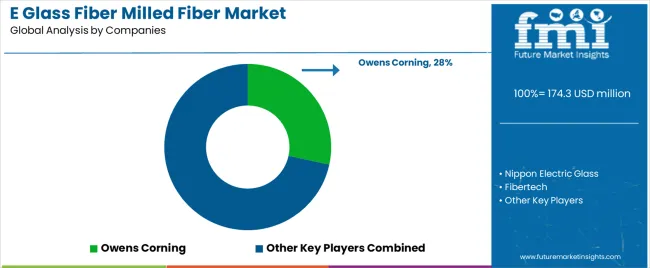
The E glass fiber milled fiber market is characterized by competition among established composite material manufacturers, specialized glass fiber companies, and integrated reinforcement providers. Companies are investing in advanced milling technologies, specialized surface treatment engineering, product innovation capabilities, and comprehensive distribution networks to deliver consistent, high-quality, and reliable milled fiber systems. Innovation in fiber processing optimization, surface treatment advancement, and performance-focused product development is central to strengthening market position and customer satisfaction.
Owens Corning leads the market with 28.4% share with a strong focus on glass fiber technology innovation and comprehensive composite material solutions, offering automotive and aerospace systems with emphasis on performance excellence and engineering heritage. Nippon Electric Glass provides integrated composite manufacturing with a focus on industrial market applications and precision control networks. Fibertech delivers comprehensive reinforcement technology solutions with a focus on automotive positioning and operational efficiency. China Jushi specializes in comprehensive fiber systems with an emphasis on manufacturing applications. Taishan Fiberglass focuses on comprehensive composite materials with advanced design and premium positioning capabilities.
The success of E glass fiber milled fiber in meeting composite manufacturing demands, material performance requirements, and operational integration will not only enhance manufacturing performance outcomes but also strengthen global composite technology manufacturing capabilities. It will consolidate emerging regions' positions as hubs for efficient milled fiber production and align advanced economies with comprehensive composite systems. This calls for a concerted effort by all stakeholders -- governments, industry bodies, manufacturers, distributors, and investors. Each can be a crucial enabler in preparing the market for its next phase of growth.
| Items | Values |
|---|---|
| Quantitative Units (2025) | USD 174.3 million |
| Type | Alkali-free Glass Fiber Type, Medium Alkali Glass Fiber Type, Other Specialty Formulations |
| Application | BMC Molding, Thermoplastic Compounding, Sheet Molding Compounds, Others |
| Fiber Length | Short Length, Medium Length, Long Length |
| Surface Treatment | Silane Treated, Amino Silane Treated, Specialty Coating |
| Regions Covered | North America, Europe, Asia Pacific, Latin America, Middle East & Africa, Other Regions |
| Countries Covered | China, India, Germany, Brazil, United States, United Kingdom, Japan, and 40+ countries |
| Key Companies Profiled | Owens Corning, Nippon Electric Glass, Fibertech, China Jushi, Taishan Fiberglass, and other leading E glass fiber milled fiber companies |
| Additional Attributes | Dollar sales by type, application, fiber length, surface treatment, and region; regional demand trends, competitive landscape, technological advancements in fiber engineering, surface treatment optimization initiatives, performance enhancement programs, and premium product development strategies |
The global e glass fiber milled fiber market is estimated to be valued at USD 174.3 million in 2025.
The market size for the e glass fiber milled fiber market is projected to reach USD 265.5 million by 2035.
The e glass fiber milled fiber market is expected to grow at a 4.3% CAGR between 2025 and 2035.
The key product types in e glass fiber milled fiber market are alkali-free glass fiber type, medium alkali glass fiber type and other specialty formulations.
In terms of application, bmc molding segment to command 41.7% share in the e glass fiber milled fiber market in 2025.






Full Research Suite comprises of:
Market outlook & trends analysis
Interviews & case studies
Strategic recommendations
Vendor profiles & capabilities analysis
5-year forecasts
8 regions and 60+ country-level data splits
Market segment data splits
12 months of continuous data updates
DELIVERED AS:
PDF EXCEL ONLINE
Electric Aircraft Onboard Sensors Market Size and Share Forecast Outlook 2025 to 2035
Environmentally Friendly RPET Webbing Market Size and Share Forecast Outlook 2025 to 2035
Emergency Transfer Vacuum Mattress Market Size and Share Forecast Outlook 2025 to 2035
Electromyographic Rehabilitation Stimulator Market Size and Share Forecast Outlook 2025 to 2035
Extracorporeal Membrane Oxygenation Machine Market Size and Share Forecast Outlook 2025 to 2035
Europe Radiotherapy Patient Positioning Market Size and Share Forecast Outlook 2025 to 2035
Eco-friendly Tea Packaging Market Size and Share Forecast Outlook 2025 to 2035
Embedded Banking Market Size and Share Forecast Outlook 2025 to 2035
Electrical Label Market Size and Share Forecast Outlook 2025 to 2035
External Anthelmintic for Dogs Market Size and Share Forecast Outlook 2025 to 2035
Employee Engagement Market Size and Share Forecast Outlook 2025 to 2035
ESD Divider Market Size and Share Forecast Outlook 2025 to 2035
Extra Low Interstitial Titanium Market Size and Share Forecast Outlook 2025 to 2035
Etching Process Parts Market Size and Share Forecast Outlook 2025 to 2035
Exterior Polyurethane Varnish Market Size and Share Forecast Outlook 2025 to 2035
Epoxy Casting Potting Resin Market Size and Share Forecast Outlook 2025 to 2035
Electronic Circulation Pump Market Size and Share Forecast Outlook 2025 to 2035
Electric Round Sprinklers Market Size and Share Forecast Outlook 2025 to 2035
Electric Cloth Cutting Scissors Market Size and Share Forecast Outlook 2025 to 2035
Ecommerce Software and Platform Market Size and Share Forecast Outlook 2025 to 2035

Thank you!
You will receive an email from our Business Development Manager. Please be sure to check your SPAM/JUNK folder too.
Chat With
MaRIA